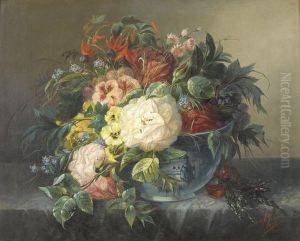Auguste Jean Baptiste Graux Paintings
Auguste Jean Baptiste Graux was a French artist known for his contributions to the world of fine arts during the 19th century. Born on January 3, 1839, in the commune of Vervins in France, Graux developed an interest in art at a young age. His early education and artistic training are not well-documented, but he likely received training at local art schools before moving to Paris to further his studies and career.
In Paris, Graux would have been exposed to the vibrant art scene and the numerous advancements happening in the world of French painting. He was a contemporary of the Impressionists, though he did not adopt their style; instead, Graux's work remained more aligned with the academic and traditional approaches to painting that were popular in the earlier part of the 19th century.
Graux's subject matter often included portraits, landscapes, and genre scenes. His work was characterized by a keen attention to detail, a classic use of composition, and a deep appreciation for color and form. Despite the lack of extensive documentation on his exhibitions and sales, it is known that he participated in the Paris Salon, a prestigious annual exhibition that was the official art exhibition of the Académie des Beaux-Arts in Paris.
Throughout his career, Graux gained a modest level of success and was respected by his peers. However, he did not achieve the same level of fame or historical significance as some of his contemporaries. His works can be found in private collections and may occasionally appear in auctions or exhibitions dedicated to artists of his time.
Auguste Jean Baptiste Graux passed away on February 24, 1913, in Saint-Quentin, France. Although he is not a widely recognized figure in the annals of art history, his contributions to French art of the 19th century provide a glimpse into the period's rich tapestry of artistic expression and the diversity of styles that coexisted during that era.
